
This week’s SEC regulation by enforcement approach has finally come to two of the largest centralized exchanges in the world: Binance and Coinbase. Despite the timing of these charges, the two cases are far from similar, though there is one common thread: allegations of securities trading on a list of tokens.
The SEC has charged US-based Coinbase with “operating its crypto asset trading platform as an unregistered national securities exchange, broker, and clearing agency.” The SEC also charged Coinbase for “failing to register the offer and sale of its crypto asset staking-as-a-service program.” Although the SEC does not attempt to clarify how these were selected, the charges include the following tokens alleged to be securities: SOL, ADA, MATIC, FIL, SAND, AXS, CHZ, FLOW, ICP, NEAR, VGX, DASH, and NEXO. This list is also non-exhaustive, so more tokens could be included at a later date. Some details were added by the regulator as to how they were determined to be securities, though a definition was not included.
One example of a securities definition in the filing is included for Chiliz (CHZ), and states that:
“the Chiliz team has disseminated information and made statements … that have led CHZ holders reasonably to view CHZ as an investment in and to expect profits from the team’s efforts to develop, expand, and grow the platform, which, in turn, would increase the demand for and the value of CHZ…The Chiliz team also frequently touts the growth potential in the sports and esports industry that it seeks to monetize through the Chiliz team’s efforts to expand its platform…Public statements that the Chiliz team and its executives made indicate that CHZ tokens are primarily deployed for purchasing “Fan Tokens” on Socios.com and that the demand for and price of CHZ tokens is directly reliant on demand for Socios fan tokens and their benefits.”
These charges follow the settlement against former Coinbase employee Ishan Wahi and his brother Nikhil Wahi. Given the timing of the settlement and the timing of the SEC charges, it’s unclear what information (if any) the SEC is using from this case against Coinbase.
For Binance, the charges are much more serious. These include allegations that founder and CEO of Binance Changpeng Zhao (CZ) and the company “publicly claimed that Binance.US was created as a separate, independent trading platform for U.S. investors, while Zhao and Binance secretly controlled the Binance.US platform’s operations behind the scenes.” Among several other violations, they also allege that “Zhao and Binance exercise control of the platforms’ customers’ assets, permitting them to comingle customer assets or divert customer assets as they please, including to an entity Zhao owned and controlled called Sigma Chain.” These charges have a strong similarity to FTX. The tokens included in this case include BNB, BUSD, SOL, ADA, MATIC, FIL, ATOM, SAND, MANA, ALGO, AXS, and COTI. Again, the SEC does not attempt to clarify how these tokens were selected with similar justifications for security definitions as the Coinbase suit.
The SEC charges against Binance have strong overlaps to the CTFC charges in March which include “willful evasion of U.S. law”.
Spot Market
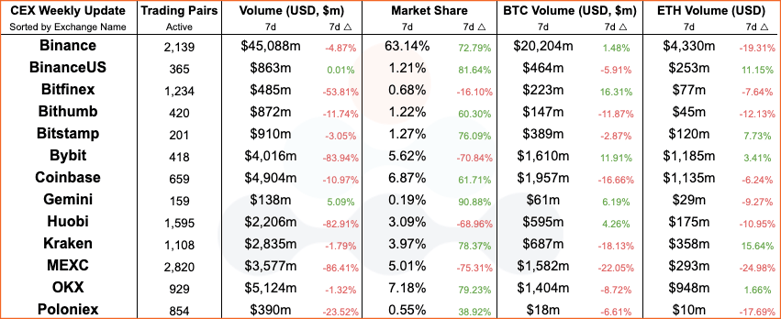
Centralized Exchange (CEX) comparisons between this and last week.
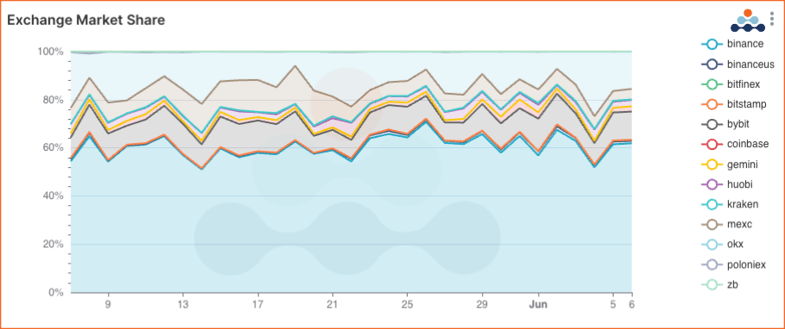
Centralized Exchange (CEX) market share for the last 31 days.
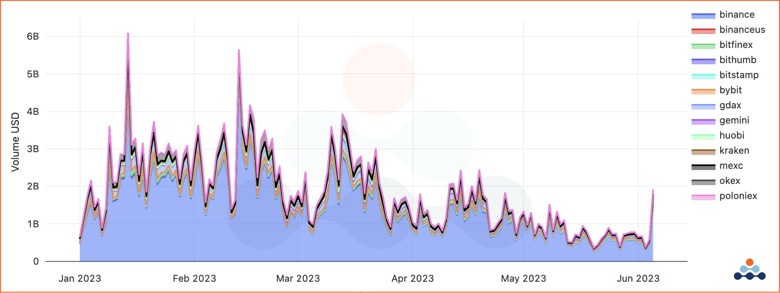
Centralized Exchange (CEX) trading volume for the SEC listed charged tokens over the last 6 months.
Binance’s market share continues a slow decline since the CFTC charges, with spikes in volume around the days of the charges. The ultimate beneficiaries of Binance’s market share decline appear to be shaping out for Bybit and MEXC. In the next few days we expect to see more spikes in trading volume (and higher trading volume market share) for Binance as users may be selling the tokens into more liquid / transferable tokens. It’s too early to tell how Coinbase’s charges will play out.
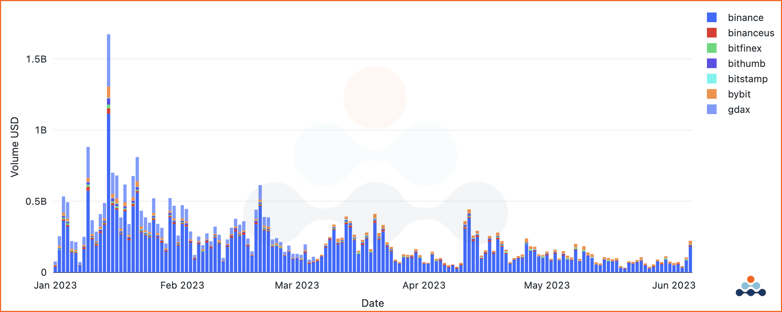
Centralized Exchange (CEX) trading volume for the SOL over the last 6 months.
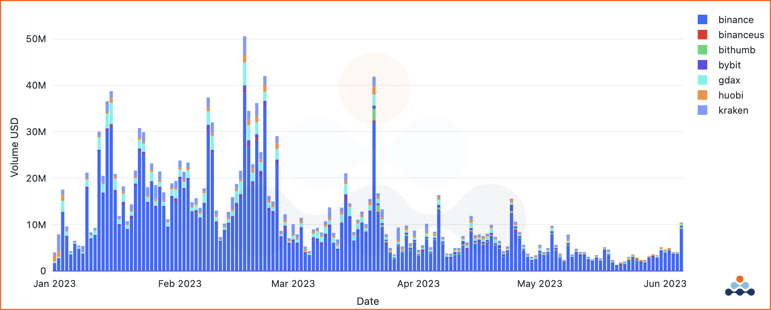
Centralized Exchange (CEX) trading volume for the FLOW over the last 6 months.
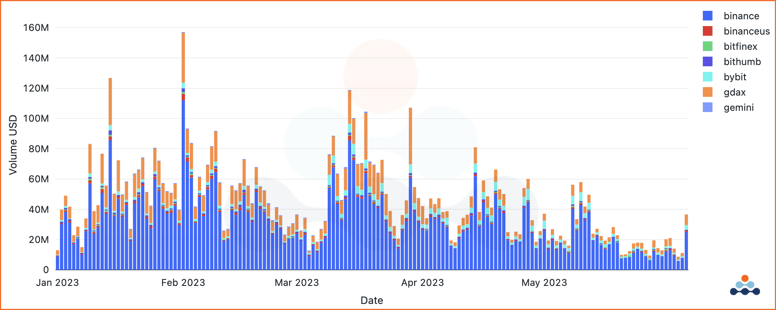
Centralized Exchange (CEX) trading volume for the ATOM over the last 6 months.
Trading volume for the tokens listed in the charges have been much higher than recent trends on Binance, which may not be a surprise given the spikes in volume for the exchange on the days following charges by CFTC and SEC. Some interesting points can be made here though: SOL volumes were slightly higher on Bybit yesterday than previous days, likely indicating that traders are moving SOL from Binance to Bybit. Trading volume for FLOW was spread across multiple CEXes in the past following the CFTC case, but more recently almost entirely concentrated within Binance – this will be an interesting plot to track over the next few days and weeks. ATOM trading volumes have been spread across several CEXs with GDAX holding previous levels. With the SEC case against Coinbase shaking out, it will be interesting to see which exchanges benefit from the suit.
DeFi DEXs

Decentralized Exchange (DEX) protocol comparisons between this and last week.

Decentralized Exchange (DEX) pool volume over the last month for SEC listed assets

Decentralized Exchange (DEX) liquidity changes over the last month for SEC listed assets.
On the DEX front, MATIC/USDC was the most highly traded token yesterday among the SEC listed assets. The accumulated volume surpassed $1 billion over the last month. Interestingly, the MATIC/WETH pool has historically been the largest MATIC trading pair, but yesterday’s MATIC/USDC pair far surpassed volumes of the WETH pair, implying traders may be fleeing for safety from MATIC to USD as volatility from the SEC suit inevitably shattles confidence in the asset.
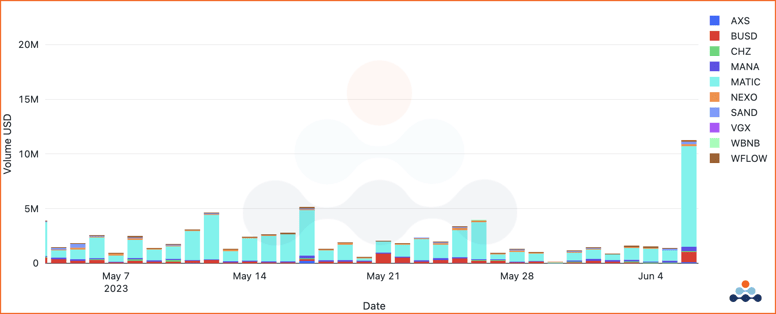
Decentralized Exchange (DEX) volume for SEC listed tokens on transactions >$100,000
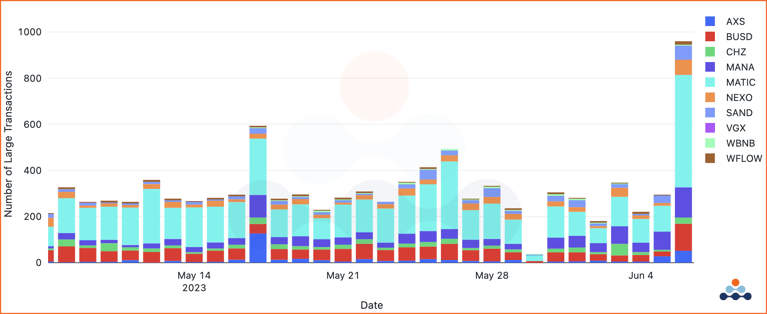
Decentralized Exchange (DEX) transaction counts for SEC listed tokens on transactions >$100,000.
Focusing on MATIC and BSD volumes, these pairs were driven in a large part by large transactions (transactions greater than $100,000). The number of transactions more than doubled their daily average transaction count (which averages ~100 transactions per day for MATIC), jumping to 487 large transactions (MATIC) yesterday.
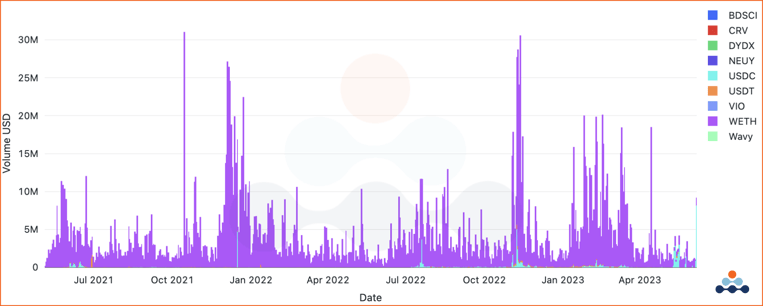
Large MATIC transactions (>$100,000) swap pair volumes.
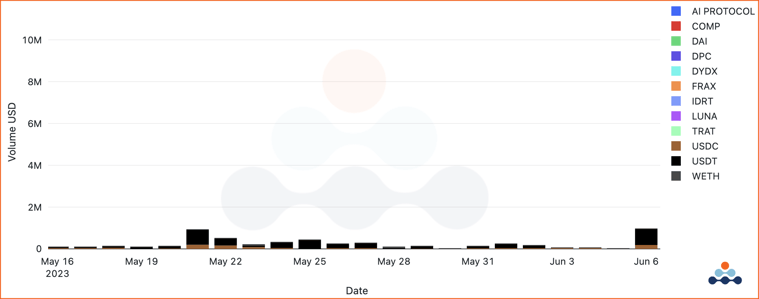
Large BNB transactions (>$100,000) swap pair volumes.
These large traders appear to be moving to USDT and USDC, with MATIC traders preferring to move into USDC and BNB traders moving to USDT. What makes this so interesting is that, despite MATIC/WETH being the preferred pair for traders, the MATIC/USDC volume far surpassed that with traders preferring the stablecoin pair as a “safe harbor.”
DeFi Borrow / Lend

DeFi Lending protocol comparisons between this and last week.
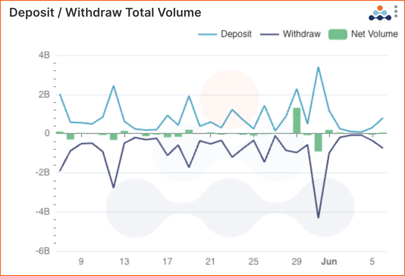
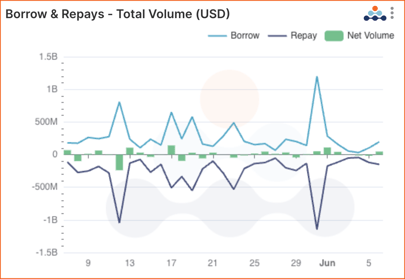
DeFi changes over the last month.
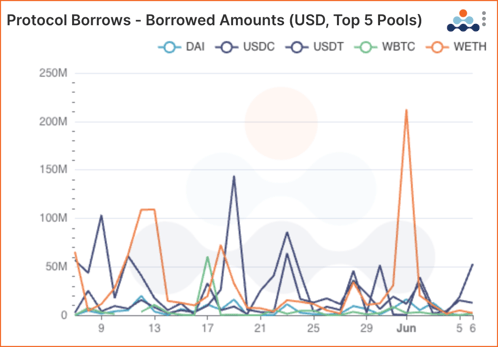
DeFi borrow volumes over the last month for the top 5 pools.
The DeFi lending field saw a recent uptick in the last few days, driven by a big jump in USDT borrowing. This outpaced USDC, which was an equally highly borrowed asset the day prior. This is interesting to note as USDC, a fiat-backed stablecoin issued by Circle through a partnership with Coinbase, has been bouncing back since its major depegging event caused by Silicon Valley Bank’s demise – which was one of the banks holding Circle’s fiat assets backing the stablecoin. USDT, on the other hand, is often more widely used outside of the United States and backed by “traditional currency, cash equivalents, and receivables from loans made by Tether to third parties” – not 1:1 traditional currency. It’s possible that this noticeable bump in borrowing volumes is driven by international investors seeking a "safe harbor" and looking to capitalize on potential price volatility that came after the two SEC charges. In addition, USDT can be traded on Binance (whereas USDC cannot).
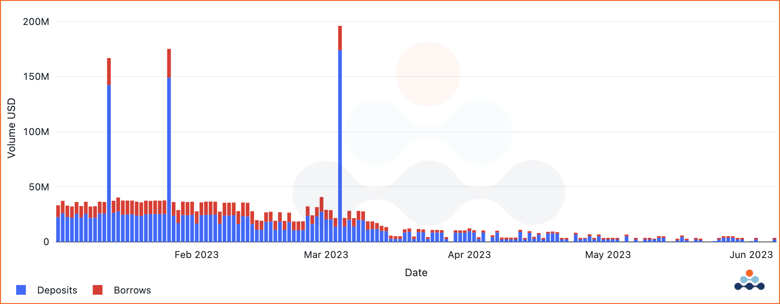
Decentralized Exchange (CEX) liquidity changes over the last month.
Focusing on the tokens included in the two suits, we can see a very minor increase in deposit volumes, likely investors looking to earn yield outside of the centralized counterparts.
Links
Recent Coverage
https://techcrunch.com/2023/06/05/binance-lawsuit-sec/
https://unchainedcrypto.com/sec-files-charges-against-binance/
Spot Market
Spot market charts were built using the following endpoints:
- https://docs.amberdata.io/reference/market-metrics-exchanges-volumes-historical
- https://docs.amberdata.io/reference/market-metrics-exchanges-assets-volumes-historical
- https://docs.amberdata.io/reference/get-market-pairs
- https://docs.amberdata.io/reference/get-historical-ohlc
Futures
Futures / Swaps charts were built using the following endpoints:
- https://docs.amberdata.io/reference/futures-exchanges-pairs
- https://docs.amberdata.io/reference/futures-ohlcv-historical
- https://docs.amberdata.io/reference/futures-funding-rates-historical
- https://docs.amberdata.io/reference/futures-long-short-ratio-historical
- https://docs.amberdata.io/reference/swaps-exchanges-reference
- https://docs.amberdata.io/reference/swaps-ohlcv-historical
- https://docs.amberdata.io/reference/swaps-funding-rates-historical
DeFi DEXes
DEX charts were built using the following endpoints:
- https://docs.amberdata.io/reference/defi-metrics-exchanges-historical
- https://docs.amberdata.io/reference/defi-liquidity-historical
DeFi Borrow / Lend
DeFi lending charts were built using the following endpoints:
Amberdata
Amberdata is the leading provider of global financial infrastructure for digital assets. Our institutional-grade solutions deliver data, analytics and comprehensive tools and insights that empower financial institutions to research, trade, and manage risk and compliance in digital assets. Amberdata serves as a...
